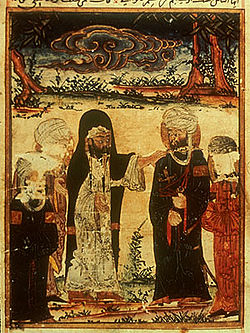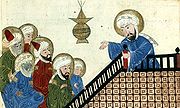
The Remaining Signs of Past Centuries
Encyclopedia


also known as Chronology of Ancient Nations or Vestiges of the Past, after the translation published by Eduard Sachau
Eduard Sachau
Karl Eduard Sachau was a German orientalist.-Biography:Sachau became professor extraordinary 1869 and full professor 1872 at the University of Vienna, and in 1876, professor at the University of Berlin, where he was appointed director of the new Seminar of Oriental languages in 1887. He travelled...
in 1879) by Abū Rayhān al-Bīrūnī, is a comparative study of calendar
Calendar
A calendar is a system of organizing days for social, religious, commercial, or administrative purposes. This is done by giving names to periods of time, typically days, weeks, months, and years. The name given to each day is known as a date. Periods in a calendar are usually, though not...
s of different cultures and civilizations, interlaced with mathematical, astronomical, and historical information, exploring the customs and religions of different peoples.
Completed in 1000 AD (AH 390/1), it is Al-Biruni's first major work, compiled in Gorgan
Gorgan
Gorgan Some east of Gorgan is the Golestan National Park. The city has a regional airport and several universities. Gorgan Airport was opened in September 2005.-Etymology:...
, at the court of Qabus
Shams al-Mo'ali Abol-hasan Ghaboos ibn Wushmgir
Qabus ibn Wushmagir Qabus ibn Wushmagir Qabus ibn Wushmagir (full name and honorific abol-ḥasan qābūs ben wušmagīr ibn ziyar šams al-maʿālī, ; (r. 977–981; 997–1012, d. 1012) was the Ziyarid ruler of Gurgan and Tabaristan in medieval Iran...
, when he was in his late twenties.
Overview
The text survives in an early 14th century Ilkhanid manuscript by Ibn al-Kutbi (the "Edinburgh codex", AH 707 / AD 1307–8, 179 folios, Northwestern Iran or northern Iraq, kept at the Edinburgh University LibraryEdinburgh University Library
Edinburgh University Library is one of the most important libraries of Scotland. It is located in Edinburgh. The University Library was moved in 1827 to William Playfair's Upper Library in the college building...
, MS Arab 161). The manuscript contains 25 paintings and survives also in an exact 17th century Ottoman copy (MS Arabe 1489, kept in the Bibliothèque nationale de France
Bibliothèque nationale de France
The is the National Library of France, located in Paris. It is intended to be the repository of all that is published in France. The current president of the library is Bruno Racine.-History:...
).
Hillenbrand (2000) interprets the choice and placement of illustrations throughout the text as a cycle which emphasizes the interest of the Ilkhanids in religions other than the predominant Islam, many illustrations showing specific episodes related to Manichaeism
Manichaeism
Manichaeism in Modern Persian Āyin e Māni; ) was one of the major Iranian Gnostic religions, originating in Sassanid Persia.Although most of the original writings of the founding prophet Mani have been lost, numerous translations and fragmentary texts have survived...
, Buddhism
Buddhism
Buddhism is a religion and philosophy encompassing a variety of traditions, beliefs and practices, largely based on teachings attributed to Siddhartha Gautama, commonly known as the Buddha . The Buddha lived and taught in the northeastern Indian subcontinent some time between the 6th and 4th...
, Judaism
Judaism
Judaism ) is the "religion, philosophy, and way of life" of the Jewish people...
, and Christianity
Christianity
Christianity is a monotheistic religion based on the life and teachings of Jesus as presented in canonical gospels and other New Testament writings...
. Other illustrations show a keen interest in topics of history and science. The account of the birth of Julius Caesar
Julius Caesar
Gaius Julius Caesar was a Roman general and statesman and a distinguished writer of Latin prose. He played a critical role in the gradual transformation of the Roman Republic into the Roman Empire....
is illustrated with a realistic rendition of a cesarean section.
The Shi`ite inclination of those responsible for the production is particularly evident from the two concluding images, the largest and most accomplished in the manuscript, which illustrate two episodes in the life of Muhammad
Muhammad
Muhammad |ligature]] at U+FDF4 ;Arabic pronunciation varies regionally; the first vowel ranges from ~~; the second and the last vowel: ~~~. There are dialects which have no stress. In Egypt, it is pronounced not in religious contexts...
, both centrally involving `Ali, Hasan
Hasan ibn Ali
Al-Hasan ibn ‘Alī ibn Abī Tālib is an important figure in Islam, the son of Fatimah the daughter of the Islamic prophet Muhammad, and of the fourth Caliph Ali ibn Abi Talib. Hasan is a member of the Ahl al-Bayt and Ahl al-Kisa...
, and Husayn
Husayn ibn Ali
Hussein ibn ‘Alī ibn Abī Ṭālib was the son of ‘Alī ibn Abī Ṭālib and Fātimah Zahrā...
: The Day of Cursing (fol. 161r) and The Investiture of `Ali at Ghadir Khumm
Ghadir Khumm
Wadi Rabigh is a wadi situated inland of the town of Rabigh, extending along the border of the Al Madinah and Makkah provinces of Saudi Arabia....
(fol. 162r). The manuscript has a total of five images depicting Muhammad
Depictions of Muhammad
The permissibility of depictions of Muhammad, the founder of Islam, has long been a concern in the history of Islam. Oral and written descriptions are readily accepted by all traditions of Islam, but there is disagreement about visual depictions....
, including the first miniature which shows the Prophet as he prohibits Nasīʾ, a form of intercalary months practiced in Arabia (fol. 6v).
The style of the images is kept in a hybrid style between that of pre-Mongol period Persia and the Chinese style introduced with the Mongol invasions.
History
He discussed his idea of historyHistory
History is the discovery, collection, organization, and presentation of information about past events. History can also mean the period of time after writing was invented. Scholars who write about history are called historians...
in The Chronology of the Ancient Nations, also known as The Remaining Signs of Past Centuries. It is a comparative study of calendar
Calendar
A calendar is a system of organizing days for social, religious, commercial, or administrative purposes. This is done by giving names to periods of time, typically days, weeks, months, and years. The name given to each day is known as a date. Periods in a calendar are usually, though not...
s of different cultures and civilizations, interlaced with mathematical, astronomical, and historical information, exploring the customs and religions of different peoples.
In The Chronology Of Ancient Nations, he mentions the birth and death of the Caliph
Caliph
The Caliph is the head of state in a Caliphate, and the title for the ruler of the Islamic Ummah, an Islamic community ruled by the Shari'ah. It is a transcribed version of the Arabic word which means "successor" or "representative"...
s, Shia Imams, Fatimah
Fatimah
Fatimah was a daughter of the Islamic prophet Muhammad from his first wife Khadijah bint Khuwaylid. She is regarded by Muslims as an exemplar for men and women. She remained at her father's side through the difficulties suffered by him at the hands of the Quraysh of Mecca...
(daughter of Muhammad) and Khadija (Muhammad's wife).
Mathematical geography
Discussing the astrolabeAstrolabe
An astrolabe is an elaborate inclinometer, historically used by astronomers, navigators, and astrologers. Its many uses include locating and predicting the positions of the Sun, Moon, planets, and stars, determining local time given local latitude and longitude, surveying, triangulation, and to...
, Al-Biruni considers the an orthographic
Orthographic projection
Orthographic projection is a means of representing a three-dimensional object in two dimensions. It is a form of parallel projection, where all the projection lines are orthogonal to the projection plane, resulting in every plane of the scene appearing in affine transformation on the viewing surface...
cylindrical projection as his own invention, expanding upon the work of Al-Saghani
Al-saghani
Abu Hamid Ahmed ibn Mohammed al-Saghani al-Asturlabi was a Persian astronomer and historian of science. He flourished in Baghdad, where he died in 990 AD....
.
Editions
- C. Eduard SachauEduard SachauKarl Eduard Sachau was a German orientalist.-Biography:Sachau became professor extraordinary 1869 and full professor 1872 at the University of Vienna, and in 1876, professor at the University of Berlin, where he was appointed director of the new Seminar of Oriental languages in 1887. He travelled...
(ed.), Chronologie orientalischer Völker von Alberuni, Leipzig 1878 (Internet Archive link), reprinted Leipzig 1923, Baghdad 1963. - C. Eduard Sachau (trans.), The Chronology of Ancient Nations: An English Version of the Arabic Text of the Athâr-ul-Bâkiya of Albîrûnî, or 'Vestiges of the Past', Collected and Reduced ... by the Author in A. H. 390 - 1, A. D. 1000 , London 1879 (Internet Archive link).
- 1969 reprint: Minerva-Verlag; Unverand edition.
- 1984 reprint: Aristide D Caratzas Pub. ISBN 978-0892411788.
- 2002 reprint: Adamant Media Corporation, ISBN 978-1402160790.
- 2004 reprint: Kessinger Publishing, ISBN 0766189082.

